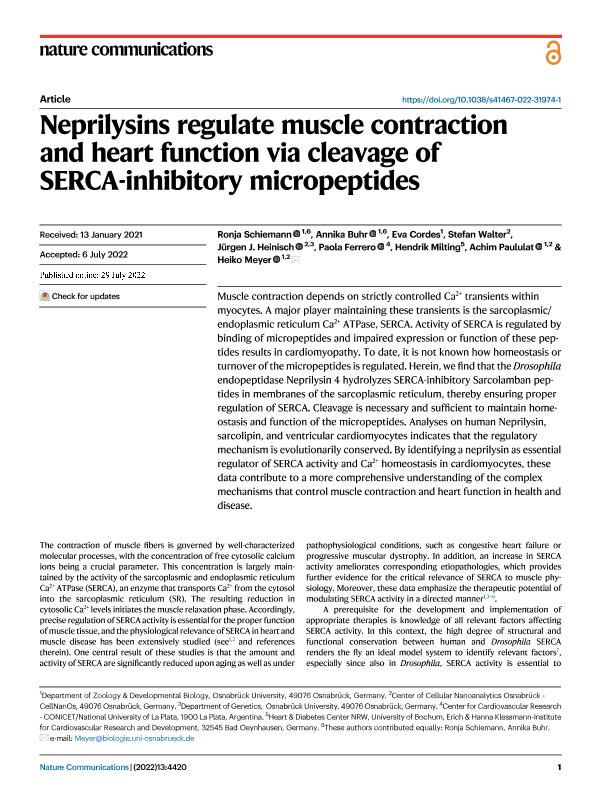Artículo
Neprilysins regulate muscle contraction and heart function via cleavage of SERCA-inhibitory micropeptides
Schiemann, Ronja; Buhr, Annika; Cordes, Eva; Walter, Stefan; Heinisch, Jürgen J.; Ferrero, Paola Viviana ; Milting, Hendrik; Paululat, Achim; Meyer, Heiko
; Milting, Hendrik; Paululat, Achim; Meyer, Heiko
 ; Milting, Hendrik; Paululat, Achim; Meyer, Heiko
; Milting, Hendrik; Paululat, Achim; Meyer, Heiko
Fecha de publicación:
12/2022
Editorial:
Nature
Revista:
Nature Communications
ISSN:
2041-1723
Idioma:
Inglés
Tipo de recurso:
Artículo publicado
Clasificación temática:
Resumen
Muscle contraction depends on strictly controlled Ca2+ transients within myocytes. A major player maintaining these transients is the sarcoplasmic/endoplasmic reticulum Ca2+ ATPase, SERCA. Activity of SERCA is regulated by binding of micropeptides and impaired expression or function of these peptides results in cardiomyopathy. To date, it is not known how homeostasis or turnover of the micropeptides is regulated. Herein, we find that the Drosophila endopeptidase Neprilysin 4 hydrolyzes SERCA-inhibitory Sarcolamban peptides in membranes of the sarcoplasmic reticulum, thereby ensuring proper regulation of SERCA. Cleavage is necessary and sufficient to maintain homeostasis and function of the micropeptides. Analyses on human Neprilysin, sarcolipin, and ventricular cardiomyocytes indicates that the regulatory mechanism is evolutionarily conserved. By identifying a neprilysin as essential regulator of SERCA activity and Ca2+ homeostasis in cardiomyocytes, these data contribute to a more comprehensive understanding of the complex mechanisms that control muscle contraction and heart function in health and disease.
Palabras clave:
calcium signalling
,
proteases
,
cardiovascular biology
,
peptides
Archivos asociados
Licencia
Identificadores
Colecciones
Articulos(CIC)
Articulos de CENTRO DE INVEST.CARDIOVASCULARES (I)
Articulos de CENTRO DE INVEST.CARDIOVASCULARES (I)
Citación
Schiemann, Ronja; Buhr, Annika; Cordes, Eva; Walter, Stefan; Heinisch, Jürgen J.; et al.; Neprilysins regulate muscle contraction and heart function via cleavage of SERCA-inhibitory micropeptides; Nature; Nature Communications; 13; 1; 12-2022; 1-18
Compartir
Altmétricas



